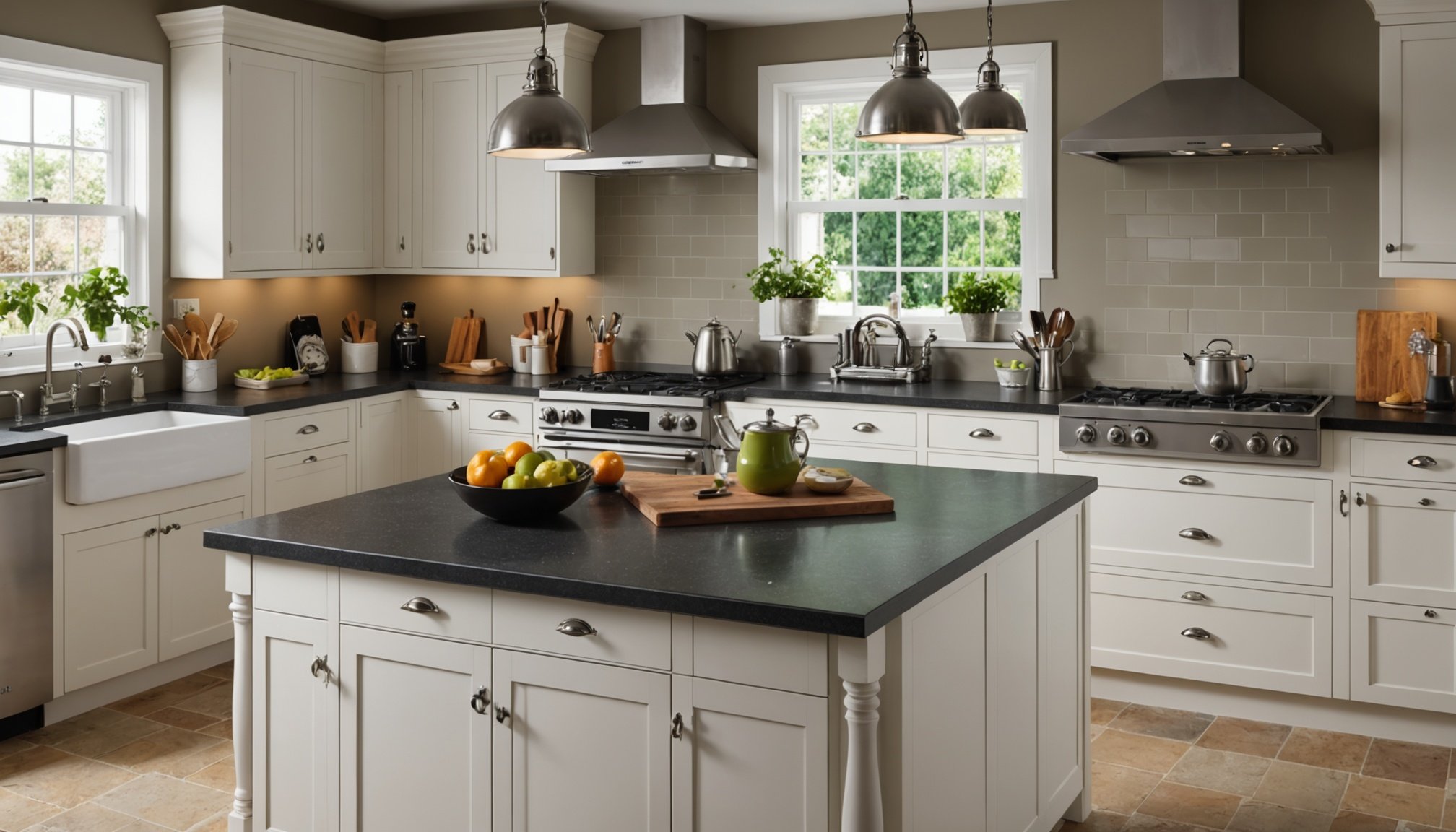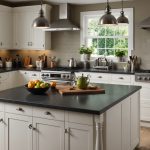Overview of Kitchen Countertop Materials
Choosing the perfect kitchen countertop material is a balancing act of style, durability, and budget. In the UK, countless countertop options cater to diverse tastes and design preferences. Common materials include granite, quartz, laminate, and wood—each with unique advantages and considerations.
The allure of stylish countertops is undeniable. They offer a chance to express personality and enhance the overall aesthetic of a kitchen space. But beyond the eye-catching visuals, the significance of durable surfaces cannot be overstated; they endure the harsh trials of daily kitchen activity over years or decades. Granite and quartz, for example, are renowned for their resilience, while laminate and wood offer more cost-effective alternatives with varying durability.
This might interest you : Ultimate guide to installing a home elevator in your uk townhouse: proven tips and best practices revealed
Cost implications are vital when heading into a kitchen revamp. Granite and quartz, though pricier upfront, often reward with longevity. Conversely, laminate and wood provide budget-friendly paths, although they may require more frequent replacement or maintenance. Installation considerations also play a crucial role; each material comes with its own set of challenges and advantages, influencing the decision-making process. Evaluating these aspects carefully will lead to a valuable, enduring kitchen centerpiece.
Granite Countertops
Granite has increasingly become a popular choice for kitchen countertops, appreciated for its aesthetic appeal and robustness. This natural stone offers an array of stylish countertops options, boasting unique patterns and a polished finish that can elevate any kitchen design.
Also to read : Mastering the art of home automation: effective approaches for harmonizing modern tech with historic uk homes
Characteristics of Granite
Granite is a natural igneous rock, primarily composed of quartz, feldspar, and mica. It is recognised for its durable surfaces, capable of withstanding high temperatures and resisting scratches. The stone’s unique mineral composition ensures that each granite slab is one-of-a-kind, enhancing its desirability for those seeking an exclusive touch.
Advantages of Choosing Granite
Benefits of granite include its remarkable durability and timeless beauty. It is resilient to heat, making it perfect for busy kitchens. Moreover, granite countertops add substantial value to a home, potentially increasing its market desirability. The robust surface is suitable for various kitchen activities, from meal prep to hosting gatherings.
Maintenance Tips for Granite
To maintain the longevity and lustre of granite countertops, regular sealing is recommended. This process prevents stains and moisture from penetrating the surface. Cleaning with a mild detergent or a specialised granite cleaner helps retain the stone’s natural glow. Avoid abrasive cleaners to preserve the polished finish.
Quartz Countertops
Quartz countertops have surged in popularity due to their modern aesthetic and robust properties. This engineered stone is composed of natural quartz crystals combined with resins, creating a durable and non-porous surface that is both stylish and functional, making it an ideal choice for contemporary kitchens.
What is Quartz?
Quartz used in countertops is an engineered stone, made from approximately 90% crushed natural quartz and 10% resins, polymers, and pigments. This composition results in an exceptionally hard surface, comparable to granite, and offers a wide range of colour choices unavailable in natural stones. Unlike natural stone, quartz is non-porous, which means it resists staining and requires less maintenance.
Pros and Cons of Quartz Countertops
Quartz benefits include exceptional durability, a broad colour palette, and resistance to scratches and stains. However, it is important to note some limitations. While heat resistant, quartz is not as tolerant to high temperatures as granite; trivets are recommended for hot cookware. Additionally, quartz countertops tend to be more expensive than options like laminate or wood, and their weight requires professional installation.
Care and Maintenance for Quartz
Maintaining quartz countertops is straightforward. Simple cleaning with mild soap and water will preserve their appearance. Avoid harsh chemicals and abrasive cleaners, as these can dull the surface. Regular maintenance is minimal, thanks to quartz’s inherently resilient nature.
Laminate Countertops
Laminate countertops offer an affordable option for homeowners seeking a stylish kitchen without a hefty price tag. These countertops are popular due to their versatility in design and cost-effectiveness.
Features of Laminate Countertops
Laminate countertops are constructed by layering paper or fabric with resin under high pressure. This results in a durable surface that simulates the look of more expensive materials. A benefit of laminate is its wide array of stylish countertops designs, ranging from bold colours to mimicking natural stone or wood patterns, providing endless aesthetic possibilities.
Benefits and Limitations of Laminate
The primary advantage of laminate is its affordability compared to materials like granite or quartz. It requires minimal maintenance, making it appealing for busy households. However, laminate is susceptible to scratches and heat damage. Unlike granite, it cannot be sanded or repaired, and these durable surfaces may not last as long if not taken care of properly.
Maintaining Laminate Surfaces
Regular maintenance is key to preserving laminate countertops. Clean with mild soap and water, avoiding abrasive sponges that could scratch the surface. Use cutting boards and trivets to protect against scratches and heat. With proper care, laminate countertops can remain a cost-effective and stylish kitchen feature.
Wood Countertops
Wood countertops bring an element of natural warmth and richness to kitchen designs. Their classic appeal and versatility make them a favoured choice among homeowners.
Types of Wood Used for Countertops
Wood countertops come in various styles, including butcher block—a popular option for its durability and unique grain patterns. Common wood varieties include maple, cherry, oak, and walnut. Each type offers distinct characteristics, ranging from colour variations to hardness levels, impacting both aesthetics and longevity.
Pros and Cons of Wood Surfaces
Choosing wood countertops allows for a blend of tradition and elegance. Key benefits highlight their stylish countertops appeal and ability to complement various kitchen styles. Beyond looks, wood surfaces are gentle on dishware and knives. However, they require diligent wood maintenance. Water damage, staining, and scratches are common drawbacks. Regular oiling and sealing are necessary to maintain their appearance and functionality.
How to Care for Wood Countertops
Proper care ensures the enduring beauty of wood countertops. Routine cleaning with a non-abrasive cloth and mild soap keeps them spotless. To preserve durable surfaces, apply mineral oil regularly, safeguarding against drying and cracking. Quick attention to spills helps prevent irreversible damage, ensuring a long-lasting and elegant kitchen feature.
Cost Comparisons of Countertop Materials
When considering kitchen countertop materials, understanding the countertop costs is essential. Price variations depend on material, installation, and long-term value. Granite, while luxurious, is pricier upfront with costs ranging from £60 to £200 per square foot. Yet, its robustness could mean fewer replacements, offering lasting value. Contrastingly, laminate is a more budget-friendly option, costing around £20 to £50 per square foot, though it may require earlier replacement due to potential wear over time.
Factors influencing budget considerations include material availability and local pricing fluctuations. Professional installation further affects pricing, with complex materials like natural stone often incurring higher labour costs compared to more straightforward installations such as laminate. The choice between DIY and professional installation also impacts costs, with professional services providing assurance but adding to expenses.
Evaluating long-term value against immediate expense helps in making informed choices. Materials like granite and quartz promise durability and lower maintenance, potentially saving costs in the long run. Meanwhile, laminate suits those prioritising initial savings. In balancing aesthetic desire and budget considerations, understanding these factors successfully guides the selection of the perfect countertop material.
Design Ideas for Kitchen Countertops
Creating a stylish kitchen that reflects your personality involves thoughtful selection of kitchen countertop materials. Let’s explore how to integrate countertops into your kitchen design effectively.
Matching Countertops with Cabinetry and Decor
Achieving harmony between countertops and cabinetry is vital for cohesive kitchen design ideas. Choose complementary colours and finishes; for instance, pair light countertops with dark cabinets for contrast, or match similar tones to maintain a seamless flow. Consider incorporating elements like wood or metal to tie in other design aspects, enhancing your stylish kitchens aesthetic.
Unique Patterns and Colours in Countertops
Experimenting with unique patterns and bold colours adds a personalised touch to any kitchen. Countertop aesthetics offer a canvas to showcase creativity, with options like veined marble, speckled granite, or vibrant tiled surfaces. Be adventurous with combinations to create a striking focal point. For a timeless look, classic whites or greys offer versatility and remain popular in contemporary settings.
Incorporating Countertops into Kitchen Layout
Functionality must accompany style in a kitchen layout. Consider the kitchen’s workflow, ensuring countertop aesthetics don’t compromise accessibility. Islands provide additional workspace and storage, creating an inviting area for social interaction. Integrate features such as breakfast bars, which extend use beyond meal preparation, complementing the kitchen’s overall functionality and appeal.
Local Availability and Installation in the UK
Selecting the right countertop suppliers in the UK ensures high-quality materials and efficient service. With numerous local shops and nationwide chains offering an array of kitchen countertop materials, homeowners have access to varied styles and budgets. Some renowned names include Howdens, Wickes, and B&Q, known for their comprehensive collections and reliable services.
Installation services play a pivotal role in ensuring the longevity and appearance of countertops. While DIY installation might seem cost-effective, professional installation often proves beneficial. Experts ensure precise fitting, particularly for heavier materials like granite and quartz, where even small errors can lead to costly damages or safety issues.
When choosing a supplier and installer, consider reviews and reputations. Seek out expert insights or recommendations from firsthand user experiences to ensure a trustworthy service. Focus on those offering warranties and post-installation support as indicators of commitment to quality.
Navigating local suppliers can be daunting, so visiting showrooms provides valuable perspectives on finishes and styles. Combining these insights with professional expertise ensures a seamless integration of stylish countertops into any kitchen space, enhancing both function and aesthetic appeal.
Consumer Reviews and Expert Opinions
Navigating the world of kitchen countertop materials becomes easier with countertop reviews and expert insights. Understanding common user experiences equips homeowners to make informed choices. Majority lean towards durability, noting how stylish countertops maintain appeal over time while enduring daily use. Reliability concerns often highlight materials like granite and quartz for their durable surfaces. Conversely, some reviews point to laminate as a versatile yet budget-friendly option.
Engaging with professional recommendations unveils valuable insights. Experts often stress the balance between aesthetics and practicality, advocating for countertops that complement a kitchen’s overall design without compromising on longevity. They suggest investing in minimal-maintenance surfaces, promoting convenience alongside style.
Common mistakes to avoid include neglecting the installation quality, which significantly affects a countertop’s lifespan and appearance. Homeowners sometimes overlook the importance of selecting a competent installer, risking improper fitting or mishaps, especially with heavier stones like granite.
Precision in choosing, informed by both user experiences and expert insights, ensures a satisfying outcome. This dual approach helps avoid pitfalls, guiding consumers towards selecting high-quality countertops that meet both their functional and stylistic needs.











